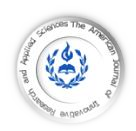
GENERAL INFORMATION


| Info-AJIRAS-® Journal ISSN 2429-5396 (Online) / Reference CIF/15/0289M |
American Journal of Innovative Research & Applied Sciences
| HOME | ABOUT US | ARCHIVE | AIMS AND SCOP | AUTHORS | REVIEW | SUMIBMIT MANUSCRIPT | EDITORIAL BOARED | PUBLICATION FEE |

| ISSN: 2429-5396 (e) | https://www.american-jiras.com | |
| Web Site Form: v 0.1.05 | JF 22 Cours, Wellington le Clairval, Lillebonne | France |
| Web Site Form: v 0.1.05 | JF 22 Cours, Wellington le Clairval, Lillebonne | France |

American Journal of innovative
Research & Applied Sciences
Research & Applied Sciences
|

ISSN 2429-5396 (Online)
OCLC Number: 920041286
OCLC Number: 920041286
| HOME || ABOUT US || ARCHIVES || AIMS AND SCOP || AUTHORS || REVIEW|| SUBMIT MANUSCRIPT || EDITORIAL BOARD |
| JUNE | VOLUME 14 | ISSUE N° 6 | 2022 |
| ARTICLE | Am. J. innov. res. appl. sci. Volume 14, Issue 6, Pages 272-280 (June, 2022)
| ARTICLE | Am. J. innov. res. appl. sci. Volume 14, Issue 6, Pages 272-280 (June, 2022)


A COMBINED APPROACH ON HEAT TRANSFER ANALYSIS FOR LED BASED AUTOMOTIVE HEADLAMPS
| Moumouni Guero Mohamed 1,2,3* | and | Prodjinonto Vincent 2,3 |. Am. J. innov. res. appl. sci. 2022; 14(6):272-280.
| PDF FULL TEXT | | XML FILE |
| Moumouni Guero Mohamed 1,2,3* | and | Prodjinonto Vincent 2,3 |. Am. J. innov. res. appl. sci. 2022; 14(6):272-280.
| PDF FULL TEXT | | XML FILE |
RESUME
Introduction: Les diodes électroluminescentes (DEL) composées d'InGaN et de phosphore jaune ont connu un développement très rapide au cours des dernières décennies grâce à leur haut rendement, leur chromaticité accordable, leur grande fiabilité et leurs avantages environnementaux. Bien que les LED présentent une efficacité de conversion énergétique très élevée, elles souffrent de nombreux problèmes dus à la température de jonction élevée (Tj). Objectif : notre objectif est d'étudier le transfert de chaleur pour les phares automobiles à LED. Une approche combinée avec la collecte de données expérimentales en utilisant une caméra infrarouge et un thermocouple pour mesurer la température sur la surface du phare, une analyse par éléments finis et une simulation numérique pour caractériser la distribution de chaleur sur le phare à LED est réalisée. En faisant varier la puissance d'entrée et la température ambiante, les effets correspondants sur la dissipation de chaleur sont observés et les points chauds sont ainsi détectés. Résultats : Enfin, une comparaison des résultats de la simulation numérique, de l'analyse par éléments finis et des données recueillies est effectuée pour vérifier la précision de l'étude. Les résultats ont montré un très bon accord avec moins de 5% d'erreur moyenne, ce qui valide la rigueur de cette étude. Cela montre que le modèle numérique peut être utilisé pour estimer les températures de surface en cas de conditions différentes dans un phare automobile.
Mots-clés : Phares à DEL pour automobiles ; imagerie thermique à haute résolution ; température de jonction ; simulations numériques, mesures thermiques.
ABSTRACT
Background: Light Emitting Diodes (LEDs) composed of InGaN, and yellow phosphorus have undergone a very rapid development over the last decades with the high efficiency, tunable chromaticity, high reliability, and environmental benefit. Although LEDs boast exceedingly high energy conversion efficiency, they are suffering from many problems due to the high junction temperature (Tj). Objective: Our objective is to investigate the heat transfer for LED based automotive headlamps. A combined approach with experimental data collection by using an infrared camera and thermocouple to measure the temperature on the surface of the headlamp, finite element analysis, and numerical simulation to characterize the heat distribution on the LED headlamp is conducted. By varying the input power and the ambient temperature, the corresponding effects on the heat dissipation are observed and thus hot spots are detected. In the end, a comparison of the results of the numerical simulation, FEA, and the collected data is performed to verify the accuracy of the study. Results: The results showed particularly good agreement with less than 5% average error, which validates the strictness of that investigation. It shows that the numerical model can be used to estimate the surface temperatures in case of different conditions in an automotive headlamp.
Keywords: Automotive LED headlamps; high-resolution thermal imaging; Junction temperature; numerical simulations, thermal measurements.
Introduction: Les diodes électroluminescentes (DEL) composées d'InGaN et de phosphore jaune ont connu un développement très rapide au cours des dernières décennies grâce à leur haut rendement, leur chromaticité accordable, leur grande fiabilité et leurs avantages environnementaux. Bien que les LED présentent une efficacité de conversion énergétique très élevée, elles souffrent de nombreux problèmes dus à la température de jonction élevée (Tj). Objectif : notre objectif est d'étudier le transfert de chaleur pour les phares automobiles à LED. Une approche combinée avec la collecte de données expérimentales en utilisant une caméra infrarouge et un thermocouple pour mesurer la température sur la surface du phare, une analyse par éléments finis et une simulation numérique pour caractériser la distribution de chaleur sur le phare à LED est réalisée. En faisant varier la puissance d'entrée et la température ambiante, les effets correspondants sur la dissipation de chaleur sont observés et les points chauds sont ainsi détectés. Résultats : Enfin, une comparaison des résultats de la simulation numérique, de l'analyse par éléments finis et des données recueillies est effectuée pour vérifier la précision de l'étude. Les résultats ont montré un très bon accord avec moins de 5% d'erreur moyenne, ce qui valide la rigueur de cette étude. Cela montre que le modèle numérique peut être utilisé pour estimer les températures de surface en cas de conditions différentes dans un phare automobile.
Mots-clés : Phares à DEL pour automobiles ; imagerie thermique à haute résolution ; température de jonction ; simulations numériques, mesures thermiques.
ABSTRACT
Background: Light Emitting Diodes (LEDs) composed of InGaN, and yellow phosphorus have undergone a very rapid development over the last decades with the high efficiency, tunable chromaticity, high reliability, and environmental benefit. Although LEDs boast exceedingly high energy conversion efficiency, they are suffering from many problems due to the high junction temperature (Tj). Objective: Our objective is to investigate the heat transfer for LED based automotive headlamps. A combined approach with experimental data collection by using an infrared camera and thermocouple to measure the temperature on the surface of the headlamp, finite element analysis, and numerical simulation to characterize the heat distribution on the LED headlamp is conducted. By varying the input power and the ambient temperature, the corresponding effects on the heat dissipation are observed and thus hot spots are detected. In the end, a comparison of the results of the numerical simulation, FEA, and the collected data is performed to verify the accuracy of the study. Results: The results showed particularly good agreement with less than 5% average error, which validates the strictness of that investigation. It shows that the numerical model can be used to estimate the surface temperatures in case of different conditions in an automotive headlamp.
Keywords: Automotive LED headlamps; high-resolution thermal imaging; Junction temperature; numerical simulations, thermal measurements.

Authors Contact
*Correspondant author and authors Copyright © 2022:
| Moumouni Guero Mohamed 1,2,3* | and | Prodjinonto Vincent 2,3 |
Affiliation.
1. Dan Dicko Dankoulodo University of Maradi, UDDM | Republic of Niger |
2. Laboratory of Energetics and Applied Mechanics | University of Abomey Calavi | Republic of Benin |
3. Department of Mechanical and Energy Engineering | Polytechnic School of Abomey-Calavi | Republic of Benin |
This article is made freely available as part of this journal's Open Access: ID | Moumouni-Ref01-ajira220422 |
*Correspondant author and authors Copyright © 2022:
| Moumouni Guero Mohamed 1,2,3* | and | Prodjinonto Vincent 2,3 |
Affiliation.
1. Dan Dicko Dankoulodo University of Maradi, UDDM | Republic of Niger |
2. Laboratory of Energetics and Applied Mechanics | University of Abomey Calavi | Republic of Benin |
3. Department of Mechanical and Energy Engineering | Polytechnic School of Abomey-Calavi | Republic of Benin |
This article is made freely available as part of this journal's Open Access: ID | Moumouni-Ref01-ajira220422 |